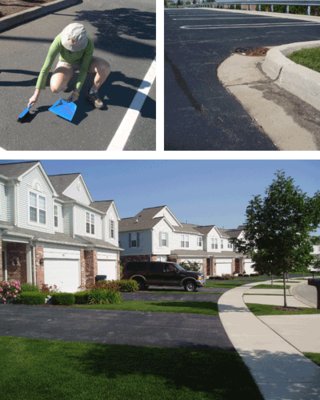
by Carolyn Gramling Thursday, January 5, 2012

Pavement dust with coal-tar-based sealant has PAH concentrations hundreds to thousands of times higher than dust from pavement with no sealant or asphalt-based sealant. USGS
Winter is hard on asphalt: Water that seeps into tiny cracks freezes and expands, breaking the asphalt apart. That’s why homeowners and business owners across the U.S. use sealants to protect their driveways and parking lots.
The trouble is, not all of that sealant stays put — part of the sealant blows away as dust that enters the environment, says Barbara Mahler, a research hydrologist at the U.S. Geological Survey in Austin, Texas. One of the most commonly used types of sealant is a coal-tar product that contains polycyclic aromatic hydrocarbons, or PAHs. PAHs occur naturally in coal, crude oil and gasoline, and are produced during burning — for example, coal gasification sites can contain elevated levels of PAHs. Coal tar-based sealants are made of up nearly 50 percent PAHs by weight — and exposure to these chemicals is linked to multiple health problems related to the eyes, kidneys and liver.
PAHs in streams, runoff, soils and other aspects of the environment across the country have been on the rise, Mahler says. One possibility is that the sealants are responsible — and there is a fingerprinting tool that can help determine the source of the PAHs. Different types of products contain an array of PAHs in varying amounts — so Mahler and scientists at USGS analyzed the proportions of PAHs in a number of different possible sources. They then studied the PAHs in 40 urban lakes across the U.S. from Alaska to Florida to look for a match to a possible source.
The results were unambiguous, she reported today at the American Geophysical Union’s fall meeting: The elevated PAH levels in the lakes were almost all due to coal tar-based sealant.
The PAH problem is more acute in the eastern than the western U.S., Mahler notes. Although it’s not yet clear why, one possibility is that people tend to use a different, oil-based sealant in the western U.S. — likely for purely economic reasons. Coal tar was a common byproduct in the smelting and manufactured gas industries, which were historically based in the eastern U.S. — making the coal tar-based product cheap and easily available in that part of the country. In the western U.S., where more oil production was based, oil-based sealants were more readily available and thus cheaper.
And that, Mahler notes, brings up an ironic point: Many defunct gas plants are now Superfund sites, in part due to the residue of PAHs. “They’re spending millions of dollars to clean [those sites] up,” she says — and meanwhile, people are pouring PAHs over the parking lot next door.
But awareness of the problem is growing, she says. Some businesses have responded to the mounting data; home improvement megastores Home Depot and Lowe’s no longer carry the coal tar-based sealants. Other businesses are now offering other types of sealant to consumers looking for another option. And that’s really the current challenge, Mahler says: how best to disseminate the information to the public.
© 2008-2021. All rights reserved. Any copying, redistribution or retransmission of any of the contents of this service without the expressed written permission of the American Geosciences Institute is expressly prohibited. Click here for all copyright requests.